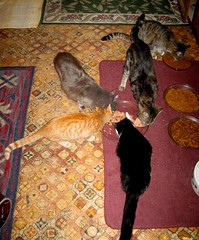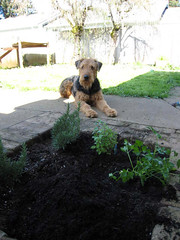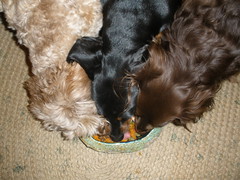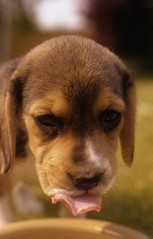 So what do I feed my cat? And how do I change their food?
So what do I feed my cat? And how do I change their food?
Anyone who has been owned by a cat knows that changing their food can be one of the hardest projects to undertake. Of course there are those cats who will eat anything but they are rare.
So how do you choose what to feed your cat and how do you find something they will eat?
Many of these rules you will recognize from my dog food article but cats are still cats and there are differences.
Here are some rules of thumb to follow with the kitties:
1. Always feed high quality food – So how do I tell what is high quality you ask

2. Here is a list of my favorite brands There are other good foods out there also but these are the ones I recommend most often. Here is a good article from Rad Cat on Transitioning to Raw Food.
- Rad Cat is one of the best raw foods out there. This company only focuses on cats and they make a great food!
- Weruva This is the only cat food that looks good enough that I would eat it! Made with whole foods and there is no question when you open the can. There fish favorites are very yummy and a good starting food to switch over the picky cats.
- Homestyle by Prairie, Instinct, Nature’s Variety raw foods are all made by Nature’s Variety. Prairie is their main line, Instinct is grain free and they also make a great raw line I recommend under the Nature’s Variety name. I have been happy with all their foods.
- Merrick makes a great line of canned and dry foods. Their foods are yummy to many cats and they have a very cute marketing campaign.
- Avoderm and Pinnacle are both solid good natural foods. Avoderm is marketed for animals with itchy skin and can make a difference in cats with environmental allergies.
- Orijen My top choice if you have to feed dry food. Orijen is a great company with a tasty, very high quality grain free food. They locally source all their ingredients and package their own food.
- Felidae is a good and solid food with some added cranberry for urinary health. Many cats really love it.
- Evanger’s makes a mackerel and gravy that many sick cats will eat when they will not eat anything else.
- Darwin’s Pet is a great northwest company which makes raw diets. If you live in the Seattle area they will deliver to your doorstep. They have a very good quality product and because they are a small company a lot of control on what goes into their food. Some cats seem to not tolerate their food as well as the Rad Cat because of the small pieces of bone in it. My cats would spit them out and leave them in the dish for me which made me wonder if they were getting enough calcium. However some cats do very well on their food.
- Go! and Now!Moderate protein diets with grain free varieties, these two foods are good solid options. Tasty options if the higher protein Orijen doesn’t work and a very good canned option
- The Natural Pet Pantry is located in Burien, Washington. They have a great cooked and raw product and will make to order if your cat needs a special diet.
- Wellness is a good solid food with good ingredients.
- Paw’s Cafe is another great local company in the Seattle area which makes homemade food, raw diets and custom diets. Great folks and very high quality diets. So far they only deliver to the Eastside but there is talk they may come over to Seattle soon. If they do they will be up there with Darwin’s.
- Update 5/20/10 Because of the recent buyout of Natura pet by Proctor and Gamble I no longer recommend Innova, Evo and California Natural and will be switching my kitties over to Orijen for dry food.
I used to feed multiple brands of food to my own cats and switch flavors and brands daily. If your cat’s stomach allows it I recommend switching brands and varieties of food. This also helps if you do need to switch their food for some health reason later in life. Now I make my own raw food and switch ingredients between meat sources.
If I have missed the food you feed your cat add a comment and I will give you my opinion on it.
3. Cats should not be on exclusively dry food ever and any cat over eight years of age (or a younger geriatric animal) should get no or very little dry food.
Cats have a funny relationship with water. They don’t drink much of it. In fact cats on dry food only are always in a slightly dehydrated state. This can lead to kidney failure, urinary tract problems and other health issues.
Dry food is cheapest and some people can not afford to feed anything but it. If dry food is all you can afford, adding a little water, chicken broth, wet food or good quality table scraps will help. There are also some animals that simply do not do well on anything but a dry food or will not eat anything but a dry food. If you feed only a dry diet make sure it is high quality and grain free.
High quality dry food with water or broth is better than low quality wet food.
4. Grain free foods vs foods with grain
 Our cats should be on a diet with a high protein content and should be eating almost all meat. I prefer cats to be on grain free diets. However, if they are feed a food with grain, meat should be at least 2/3 of the food.
Our cats should be on a diet with a high protein content and should be eating almost all meat. I prefer cats to be on grain free diets. However, if they are feed a food with grain, meat should be at least 2/3 of the food.
Animals with allergies, cancer, or epilepsy should absolutely be on a grain free diet. Many animals with chronic vomiting also do better on a grain free diet diet.
If you feed a food with grain, oats, barley, quinoa, and brown rice are ideal grain sources. Corn and wheat should not be feed to cats.
Healthy animals can be on a high quality diet with a little grain or without grain but I recommend dry food be grain free in cats.
5. Senior diets, weight loss diets and overweight cats
Just say no to senior diets! Senior diets usually reduce the amount of protein and add more grain. Older cats do not need this! Avoid anything labeled a senior diet unless it is grain free.
Weight loss diets also reduce the protein and add more bulk in grain. This is not how you get a cat to loss weight. The best way to reduce weight on your overweight cat is to feed a high protein, no grain, raw, cooked or canned food only diet! Also know as the Catkins diet.
Evo and some of the other good quality foods now have weight loss, grain free diets with reduced fat, high protein and no grain. These are ok but avoid any weight loss diet with grain.
5. The least processed the food the better (also known as dry vs canned vs raw vs cooked)
In the ideal world we would all have time to come home each day and cook for ourselves and our pets. However many people don’t have time to cook for themselves or their cats.
If you do have time to cook for your cats see my article Making crazy awesome homemade cat food.
If you can, start your cat on a raw diet or cook for them at home. There are also companies like Paw’s Cafe and Natural Pet Pantry that make homemade cat food. If you are against feeding raw food or your cat doesn’t tolerate it, raw foods can also be cooked. Crock pots and steamers are ideal for this. Although you can always throw it in a frying pan.
If you feed a raw diet make sure you use a commercial product that is frozen or if you make your own freeze it before using it to kill of any potential parasites.
In cats if you make a cooked food, you must add a supplement with taurine to it. Cats will die without taurine and while they get enough on raw food there is a debate on if they get enough from cooked. To be safe always add some to homemade cooked food. Commercial foods already add it.
In general the less proceeded the food the better. With raw being on the top, followed by cooked, canned and finally dry. But do what works for your household.
There are almost no overweight cats on raw diets. If your cat is overweight get them off the dry food.
< Any cat who has had urinary tract problems should be on a diet without dry food and the best way to prevent urinary problems is to avoid dry food.
Any cat who has had urinary tract problems should be on a diet without dry food and the best way to prevent urinary problems is to avoid dry food.
My own cats cats used to eat high quality canned food with a little dry Orijen overnight. I only added the dry after I discovered that my older cat needed a little at night or he would vomit up bile. My older cat has since passed away but I have a new girl who loves her “crunchies” so I still feed little dry in the evening along with homemade raw.
While I have a number of animals on homemade or raw diets, many of my clients feed their cats a mixture of high quality dry and wet because of convenience and cost.
6. Pick the meat which is best for your cat. If possible rotate meat sources.
If your animal has obvious allergies then this choice is made for you. If not, I am highly in favor of switching protein sources routinely. This reduces your animals chance of developing allergies and adds some variety to your their diet. Imagine if you had to eat the same thing over and over again. Boring!
Chinese medicine also has an energetic system for working with food. See my article The dance of life and the energetics of food for more information.
I do not recommend feeding pork to cats because of the way pigs are raised and the energetics that go along with that. Pork must never be eaten raw because of the diseases that pigs carry.
Tuna should be limited to one can a week. For foods with just a little tuna for favor use your own judgement. Tuna is high in heavy metals and can also lead to problems with vitamin B deficiency. The exception to this is when you are working with a picky cat who doesn’t like canned food. Many times starting with the tuna flavors will help switch them over and then you can add in other canned foods. Never feed straight human tuna because without the added vitamins you end up with vitamin B and E deficiencies.
7. Table scraps are ok
No really, I know we as a veterinary community have told you they aren’t. But if you eat healthy food it is fine for your cat to have some. Just remember – no onions or chocolate.
8. For animals in kidney failure, the quality of the protein is much more important than the amount of protein.
For years the veterinary community has recommended low protein for cats in kidney failure. The new studies out however show that diets moderate in very high quality protein are best for these animals.
The best thing you can do for your cat in kidney failure is to keep them off the dry food. Feed high quality canned or home cooked with moderate protein. I do not recommend switching a cat with kidney failure to a raw diet if they are not already on one.
Avoid the low quality, low protein prescription kidney diets.
For more information on kidney failure and cats see my article Kidney failure in cats – how Chinese medicine and diet can help
9. Avoid the addictive grocery store brands like Friskies and Fancy Freast
 These foods are highly addictive to cats and it is very hard to get your cat off of them once they are on them.
These foods are highly addictive to cats and it is very hard to get your cat off of them once they are on them.
High in wheat, corn, soy, and salt and with animal by-product (euthanized cats and dogs with a little euthanasia solution in it) this is the last thing you want to feed your cat. Yuck!
However many cats love these foods. The high salt and artificial flavors make them highly addictive. Stay away from these at all costs!
Not only are they not good for your cat’s health but there also seems to be a higher rate of urinary tract disease in cats on these foods.
10. How do I switch over my picky cat to a new food?
Cats can be hard to switch over to a new food. Sometimes nothing can seem more impossible. Here is a few things that can help.
- If you are switching to raw, cook it and salt it first. And then mix a little in with their normal food.
- Get free samples at the pet store or buy many small cans of food to try. There may be one magic flavor that does it for your cat’s pallet.
- If your cat likes fish and you are switching to a canned food try Weruva’s fish flavors or Evanger’s mackerel with gravy. If your cat is into poultry try Weruva’s chicken and gravy or Instinct’s chicken.
- If your cat will not eat canned food, add a little salt. You can take it away slowly after they are eating the wet food.
- Mix the new food in with their old food. Just add a little at first and then increase it
- If they are not sick, give them three days not to eat. Most cats will eat what you offer on the third day. If your cat is overweight absolutely do not fast them for more than three days. If overweight cats do not eat for more than three days they are at risk of a disease called hepatic lipidosis which can be deadly!

- If you are switching their dry, try Orijen – most cats like it’s flavor and will eat it, even the picky ones
- Some cats get soft stools when being switched over to a new food. This should improve in a week. If it doesn’t try another food.
I hope this information helps. Do the best you can with it and try to have fun! After all, you know your cat better than anyone else!
Helpful links
Dog Aware’s dog food page More information than you could ever use about dog food!. While this is a dog site much of the information on it is also relative to cats.
Born Free’s What’s Really In Pet Food A great article about pet food companies and processing.
Books about cat food and diet
Dr. Pitcairn’s New Complete Guide to Natural Health for Dogs and Cats
The Whole Pet Diet: Eight Weeks to Great Health for Dogs and Cats
The Natural Cat: The Comprehensive Guide to Optimum Care
Natural Nutrition for Cats: The Path to Purr-fect Health
Food Pets Die For: Shocking Facts About Pet Food
Not Fit for a Dog!: The Truth About Manufactured Dog and Cat Food
Home-Prepared Dog & Cat Diets: the Healthful Alternative
Update – Since writing this article I’ve gotten to participate in a great thread of questions about it on the West Seattle Blog. Please check out the post How to pick a good cat food where I also explain how to figure out the exact amount of food your cat needs.
Also see How do I pick the best food for my dog’s health?.
 Most of us do not practice all holistic modalities, and even those with a wide area of systems they work with, usually have a few they are very good at and some that they just do a little of.
Most of us do not practice all holistic modalities, and even those with a wide area of systems they work with, usually have a few they are very good at and some that they just do a little of.









